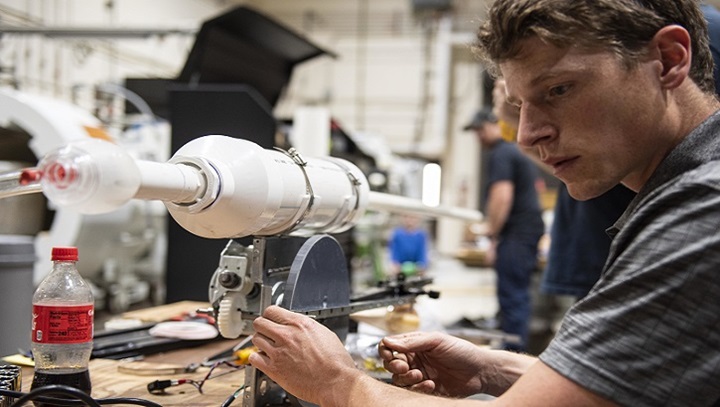
Courtesy of Eddie Green
Timothy Foldy-Porto ’20 drew up the design for a ventilator-splitting device in 30 minutes.
Now, almost a month after this first sketch, Foldy-Porto, Brian Beitler MED ’22 and Peter Kahn, a resident at Yale New Haven Hospital, are planning to distribute thousands of Vent Multiplexors — the first device capable of splitting a ventilator feed while allowing for individualized care for both patients on the ventilator — to hospitals around the world. Since drawing up these first designs, they have started a company, been granted Emergency Use Authorization by the Food and Drug Administration and successfully co-ventilated two critically ill patients at YNHH.
“We must do everything possible to deliver life-saving crisis rescue care,” Kahn said in a company press release after the successful coventilation. “Having an affordable, state of the art approach to individualized patient care during emergency co-ventilation will give hospitals yet another critical weapon in the fight to save lives.”
To use traditional ventilator splitters, doctors must find patients with similar lung capacities to share a ventilator. Even if they are able to do this, “there is no way to monitor or control the amount of air that either patient is receiving,” Beitler wrote in an email to the News. The new device is unique because it allows doctors to provide individualized care to each patient on the ventilator.
The vent multiplexor both measures the tidal volume — the amount of air inhaled and exhaled with each breath — of the two patients on the ventilator and allows doctors to control the amount of air each patient receives. The crux of the design idea came from a class on jet engines that Foldy-Porto had taken at Yale, Beitler told the News. The device utilizes Venturi tubes to measure and regulate the amount of air each patient receives.
The FDA granted Emergency Use Authorization for the vent multiplexor on April 15. The Emergency Use Authorization is a FDA protocol that allows for the use of the unapproved medical product due to the danger of the COVID-19 pandemic and because there are no adequate alternatives.
Kahn managed the administrative side of creating Vent Multiplexor LLC, including seeking FDA authorization, while Beitler and Foldy-Porto designed and tested the device.
Though the two had worked together on a previous project, they came together to create the vent multiplexor at a CHIME meeting in late March. The March 19 meeting centered on producing devices to address the COVID-19 crisis. Beitler mentioned at the meeting that he was considering how to split one ventilator feed to treat two patients to address the ventilator shortage many hospitals were projected to face.
“Looking at the news I realized that the ventilator shortage was a pressing issue we were facing with COVID-19,” Beitler told the News. “I thought that probably the best short-term solution was to come up with a way to have one ventilator ventilate multiple patients.”
Some 30 minutes after the meeting, Foldy-Porto had sketched up the designs that would ultimately become the Vent Multiplexor. He presented the blueprint to Beitler, and the two started creating a prototype the next day.
“That was pretty intense,” Foldy-Porto said of the process of creating and refining prototypes. “That was where I was spending all my time for two weeks straight….I didn’t do that much homework during that time.”
He 3D-printed this first design on his personal 3D printer, but it did not work “because it never does on the first try,” Foldy-Porto told the News. But on the third iteration, the device worked, and Beitler brought it to YNHH to test on ventilators attached to simulated lungs. After continually refining the design, by the end of March the two had finalized their prototype and submitted it to the FDA for authorization.
In early April, the two performed a patient test at YNHH. The device successfully co-ventilated two critically-ill adults with different lung sizes who were at different stages of the COVID-19 infection. Kahn said in a press release at the time that the device was “a critical breakthrough in emergency crisis care during the COVID-19 pandemic.”
“There were a lot of people — senior members of the hospital — who were present at that test who before were skeptical, and the test went off without a hitch,” Foldy-Porto said. “I think that helped turn the tide in our favor.”
Kahn, who partnered with the two early on in the process, helped them navigate the business side of creating Vent Multiplexor LLC. They filed a provisional patent for the device in late March. They opted to form a company to manufacture and distribute the device themselves, thereby ensuring it gets to hospitals. Foldy-Porto explained that many people can produce a working device, but it needs FDA authorization and the legitimacy that comes with a company name to truly reach patients.
“What is really important to us was that this was not just good enough to be a science project,” Foldy-Porto said. “It really has to actually be used.”
With this goal, they are trying to price the device at the cost of manufacturing it — around $250 per device. Ventilators cost between $25,000 and $50,000, so Foldy-Porto explained that Vent Multiplexors provide a cost-effective way for hospitals to increase their ventilator supply in case of a shortage.
Vent Multiplexor LLC has partnered with YNHH.
Rose Horowitch | rose.horowitch@yale.edu
Correction, April 29: A previous version of this article stated that Foldy-Porto and Beitler are part of CHIME. The two attended a CHIME meeting in March, but are not part of the coalition. The article has been updated to reflect these changes.







